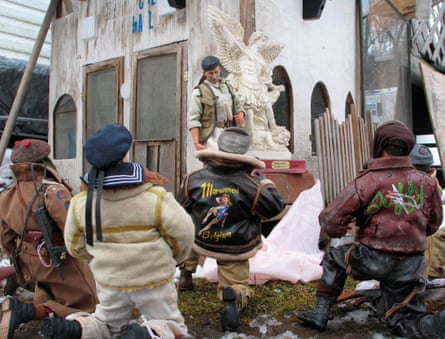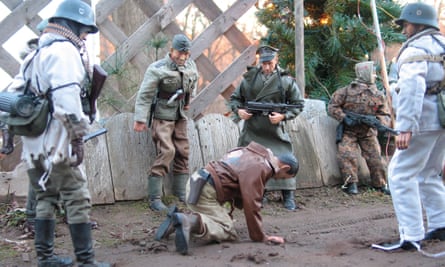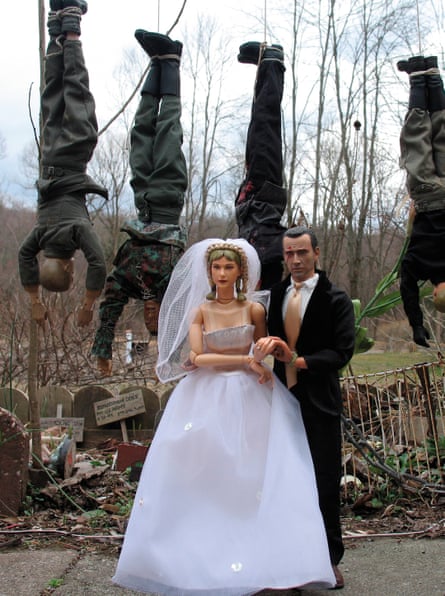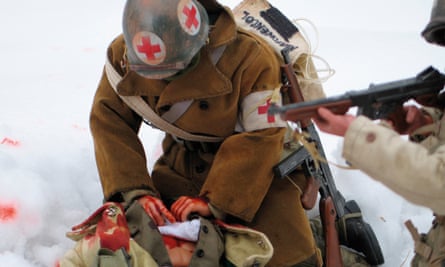Mark Hogancamp woke up one day in terrible pain in an unfamiliar room. His memory was gone. He looked up at the ceiling and tried to piece together what had happened. He knew it was 1984, he was in the navy and that this was Ibiza, but that was all he could work out. Maybe he had been beaten up and robbed the night before. How long had he been passed out? Eight hours?
There was a man standing over Hogancamp’s bed. “Do you know what year this is?” he asked Hogancamp.
“1984,” Hogancamp said.
“No,” the man said. “It’s 2000. Five guys beat you almost to death. You’ve been in a coma for nine days.”
“I forgive them,” Hogancamp said. Those were his first words after hearing about the attack: “I forgive them.”
“You wouldn’t forgive them if you knew what they did to you,” the man said.
Hogancamp is telling me this story 15 years later in his trailer home near Kingston, New York. It’s quite dark in here. Not much sunlight is getting in. There are mannequins scattered around wearing nylons and heels, and Barbie dolls, and half-painted action figures, and models of second world war cars. But there’s nothing ironic going on, nothing hipsterish. It all adds up to something amazing.
He still can’t remember the attack. “My brain is protecting me by not allowing me to remember,” he says. But from the evidence presented during the trial, this is what he knows: Hogancamp, who was 38 and an alcoholic, had gone to a local bar, the Anchorage. He was a cross-dresser. Not the full outfit – just the legs and feet, nylons and heels. “I didn’t wear the stuff out in public,” he says. “I kept it very secret. But I got talking to these guys …”
There were five of them, in their teens and early 20s, lanky, cropped-blond hair. At first, according to witnesses, they were all getting on well. One of them had German ancestry, as did Hogancamp, and so they were making Nazi jokes and having fun. But then Hogancamp told the men that he wore nylons and heels.
“I was given the ultimate truth serum, which is alcohol. I guess I thought people could handle it. But apparently not.”

The men left the bar before Hogancamp and waited for him. “I [left] the bar. And, from what I hear, I talked to them for a bit, then I turned around and started walking home, and they attacked me from behind.”
He was unconscious within seconds. But the men carried on – repeatedly stomping on his head with both feet. After a minute they ran away. He wasn’t breathing. Passersby found him and rolled him on to his side. Blood came spilling out of his nose and mouth.
“The doctors had to take my eyeball out, put it on my cheek, clean out the bone fragments, and put my eye back in,” Hogancamp tells me.
He recuperated in hospital for 40 days. But then the insurance stopped paying and so he had to go home. (His friend Tom drove him. Tom was the barman from the Anchorage – the man who had been standing over Hogancamp’s bed when he woke up from his coma.) Hogancamp was in physical therapy for a year. He was angry and in pain but at least the therapy was slowly working. He was learning how to walk again, how to talk, “how to wipe myself after a poo”. His hands were shaking less. But then his insurance company telephoned him. “The guy said: ‘You have to come up with $157 a month.’ I said: ‘I can’t afford that.’ So the asshole on the other end said: ‘Well, I guess you don’t have therapy any more!’ And he hung up.”
He lights a cigarette and pours himself some coffee.
“When my therapy was cut off I hated every man on Earth,” he says. “I felt like I’d been kicked out of the tribe of men on planet Earth. But after a month of hating everything I thought, ‘I have to do something or else this hate and anger is going to build up and kill me.’ I needed to do something.”

Three years later and one of his neighbours, David Naugle, was taking out his garbage when he noticed Hogancamp walking up and down the side of the road pulling a scale-model military jeep.
“Hey!” Naugle called out. “How many miles a gallon on that thing?”
“Fifty-eight!” Hogancamp called back.
Hogancamp was photographing the toy jeep. It seemed to be some kind of art project.
“I’m a photographer for a magazine,” Naugle called out. “Got any photographs I could look at?”
“Sure,” Hogancamp called back.
The next time Hogancamp went out, he put some photographs in Naugle’s mailbox.
“And when he saw them,” Hogancamp tells me, “he flipped out.”
For three years – unbeknown to almost everyone – Hogancamp had been meticulously constructing on the lawn behind his trailer-home a fictional second world war Belgian town called Marwencol. He built it out of found wood, windows, nails and screws. It had a painstakingly realised bar – the Ruined Stocking Cat Fight Club, “The Only One in Belgium”. The ice in the drinks was shards of broken windscreen glass that he had found on the road. There was a town hall, a bank, an ice-cream fountain, a cemetery, a petrol station. A huge cast of miniature figurines populated the town and, in Hogancamp’s photographs, they were enacting dreadful dramas upon each other.

Marwencol was a town at war. There was blood in the snow, bodies rotting in puddles, townspeople getting executed in the square. Men were getting their heads bashed in so violently you could see their brains. It was especially disturbing, and especially impressive, because the photographs were so cinematic. The lighting and depth of field made the scenarios constructed within them incredibly lifelike. In one photograph, five SS men were viciously beating an action figure that looked like Hogancamp. They took turns to stomp on his head as he lay in the mud. But in other photographs the attackers were getting their comeuppance – the women of the town were shooting four of them, while the fifth was taken outside and hanged. The action figure based on Hogancamp got married then, to a doll called Anna, in front of the dead bodies of the SS men, hanging upside down.
Hogancamp takes me to see Marwencol. On our way we pass his old television. Sometimes at night, he says, he watches his wedding videos and thinks, “Wow, she’s hot.” Since the beating, he doesn’t remember his wife at all – not a moment of their five-year marriage. He doesn’t remember his life before or after his marriage either. He only knows what others have told him – that he was born and raised in upstate New York, scraped through school, spent five years in the US Navy, left with an honourable discharge, met his wife, became an alcoholic, and ended up alone. By the time he was attacked he was drinking nearly two litres of whiskey a day.
“I needed help from God,” he says. “And so he sent five horsemen.”

We head outside. “Marwencol was solely made up so I could kill those five guys,” Hogancamp tells me. “I had no way to do it in real life. I played it over in my head. I’d get caught. I’d go to prison. I’d get the chair. The first time I killed all five of them, I felt a little bit better. That violent hatred and anger subsided a little.”
“How many times have you killed them in all?” I ask him.
“Oh, over and over,” he replies. “For 12 years now. I’ve killed them every which way. I’ve killed them in ways Satan himself hasn’t even thought of.”
In one photo story – called The Giant of Marwencol – the five SS men are torturing and humiliating two women because they’re refusing to give up “Hogie’s” location. (Hogie is the action figure based on Hogancamp.) The Nazis are whipping the women. Their backs are streaked with blood. But suddenly a giant hand reaches in – the real Hogancamp’s hand – and gently touches the SS men. “With a touch,” the caption reads, “the bodies of the SS dropped where they stood. He took their souls from their bodies and sent them to hell.”

But this is an unusual photo story: most of the time the SS men are killed by the women of the town. “The only species on Earth that haven’t attacked me are women,” Hogancamp says. “And when they heard I had over 300 pairs of high heels they said: ‘We’ll take you in our tribe.’”
(In real life, the five attackers got off pretty lightly. Two got probation. Another two were sentenced to five years in prison, and the ringleader got nine years.)
We reach Marwencol. It is no Legoland. It’s not magical. It’s small and functional and utilitarian – like a sound stage between productions. The insanely cinematic scenarios captured so beautifully in the photographs exist only in the photographs. When they are dismantled, there isn’t much left – mainly plywood and mud. Two women have followed us out here – Hogancamp’s gallerist and his publicist. They have been listening in to the interview and from time to time have called out things like, “No, we’re not going to talk about that at all” or “There’s to be no mention of where this place might be”. Usually, I find interventions like this annoying during interviews, but this time it’s understandable. Hogancamp’s brain injury has disinhibited him, and the women are here to stop him talking about things he will regret.
I am to be vague about the location because strangers sometimes show up unannounced. It has been happening ever since Hogancamp’s neighbour showed the photographs to the New York art magazine Esopus. They printed a spread. After that there were gallery shows and a feature-length documentary directed by Jeff Malmberg. There’s a new book, too – Welcome to Marwencol – that details the town in all its blood-spattered intricacies. You learn how Hogancamp makes his flesh wounds – “by heating the figure with a lighter and pressing a pen through the skin, mimicking a bullet’s trajectory … The blood is either red-coloured sugar water or nail polish, which looks wet and fresh for months, giving Mark more time to shoot”. And all this was created by a man with a brain so damaged his hands shook violently, a man who couldn’t remember how a ruler worked, even though he had once been a carpenter.

None of the acclaim has enriched Hogancamp’s life in the slightest. In fact, I think he is a little annoyed that I am here today. He tells me that a muddy day like today is the perfect terrain for creating Marwencol dramas. A muddy landscape makes the photographs look more realistic, plus it’s easier to prop the figures up when the ground is soft.
“One time, a van filled with twenty-something kids came to the door,” he tells me. “‘Are you Mark Hogancamp?’ They sat here, a couple of chicks and a dude, and looked at me like I was a guru.” He shudders. “I’m a private person. I mow my lawn. I mow my late neighbour’s lawn. I’ve spent 13 years alone. No girlfriend, no social life. I still have no social life, I have no car.”
His life may be small and secluded but his photographs are leading amazing lives. A couple of days before I drive up here, in fact, the strangest thing happened. Bruce Jenner had just come out as Caitlyn Jenner and amid the celebrations a grumpy Facebook user named Terry Coffey wrote: “As I see post after post about Bruce Jenner’s transition to a woman, and I hear words like bravery, heroism and courage, just thought I’d remind all of us what real courage, heroism and bravery looks like!” He linked to a photograph – a powerful second world war image of a US soldier carrying an injured comrade through the mud while the latter points his gun at an unseen foe.

Except Coffey had got it wrong. He had accidentally chosen one of Hogancamp’s photographs – called Rescuing the Major. After other Facebook users took great pleasure in pointing out the irony to him – that he had linked to an art project created by a cross-dresser who had been beaten almost to death by bigots – he followed up with a second post, a mea culpa: “I could have chosen one of hundreds of other photos. But I didn’t, I chose this one. Do I think it was an accident? I don’t. What happened to this man was wrong, cruel, and unforgivable. Hate helps nothing … (And irony makes us think).”
Hogancamp hasn’t touched alcohol since the night of the attack. He has no idea of what it tastes like. When I ask him if it’s because he’s worried the addiction is lying dormant, waiting to pounce, he points at his feet. He is wearing heels. His toenails are painted.
“That’s what scares me about booze,” he says. “One sip and I’ll be back to half-a-gallon a day.”
I ask when he started wearing heels again, and he tells me a story. It was the day his friend Tom drove him home from the hospital. When Hogancamp walked into his house, he saw high-heeled shoes everywhere.
“I used to wear these?” he thought. And so, out of curiosity, he tried a pair on. “And that’s all it took,” he says. “One pair of shoes and I was, ‘Oh wow!’”
Welcome to Marwencol by Mark E Hogancamp and Chris Shellen is published by Princeton Architectural Press on 3 November, £18.99.

Comments (…)
Sign in or create your Guardian account to join the discussion